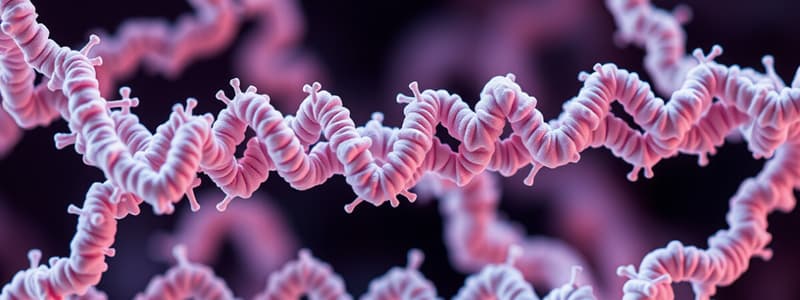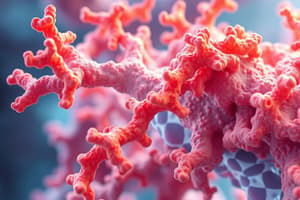Podcast
Questions and Answers
What role does glycine play in the collagen structure?
What role does glycine play in the collagen structure?
- It aids in the hydroxylation of proline.
- It facilitates crosslinking of collagen fibers.
- It is found in every third position of the polypeptide chain. (correct)
- It contributes to the glycosylation process.
Which of the following elements is NOT required for the hydroxylation of proline and lysine in collagen biosynthesis?
Which of the following elements is NOT required for the hydroxylation of proline and lysine in collagen biosynthesis?
- Oxygen
- Hydroxylating enzymes
- Ferrous form of Iron
- Hydrogen gas (correct)
What is the primary consequence of ascorbic acid deficiency in collagen synthesis?
What is the primary consequence of ascorbic acid deficiency in collagen synthesis?
- Significant rise in hydroxyproline levels
- Enhanced collagen crosslinking
- Increased hydroxylation of lysine
- Impaired interchain hydrogen bond formation (correct)
Which amino acid is primarily modified during glycosylation in collagen?
Which amino acid is primarily modified during glycosylation in collagen?
What structure is characteristic of collagen?
What structure is characteristic of collagen?
Which cell type is primarily responsible for collagen synthesis in cartilage?
Which cell type is primarily responsible for collagen synthesis in cartilage?
In collagen's repeating amino acid sequence, what does 'Y' typically represent?
In collagen's repeating amino acid sequence, what does 'Y' typically represent?
Which enzyme is NOT involved in the hydroxylation of proline in collagen synthesis?
Which enzyme is NOT involved in the hydroxylation of proline in collagen synthesis?
How do specific amino acid sequences in prepro-α chains influence collagen biosynthesis?
How do specific amino acid sequences in prepro-α chains influence collagen biosynthesis?
What effect does hydroxyproline have on collagen structure?
What effect does hydroxyproline have on collagen structure?
What is the primary role of α1-antitrypsin in relation to elastin?
What is the primary role of α1-antitrypsin in relation to elastin?
Which type of collagen is primarily involved in forming the basement membrane?
Which type of collagen is primarily involved in forming the basement membrane?
What is the fundamental structural characteristic of collagen?
What is the fundamental structural characteristic of collagen?
Which type of collagen is classified as a fibril-associated collagen?
Which type of collagen is classified as a fibril-associated collagen?
What type of collagen provides tensile strength and is abundant in tendons?
What type of collagen provides tensile strength and is abundant in tendons?
What occurs as a consequence of α1-antitrypsin deficiency?
What occurs as a consequence of α1-antitrypsin deficiency?
Which structure is defined as a semipermeable filtration barrier in the body?
Which structure is defined as a semipermeable filtration barrier in the body?
What characterizes the packing of elastin molecules observed in an electron microscope?
What characterizes the packing of elastin molecules observed in an electron microscope?
Which of the following is NOT a feature of collagen?
Which of the following is NOT a feature of collagen?
What type of collagen primarily forms a 3-dimensional mesh instead of fibrils?
What type of collagen primarily forms a 3-dimensional mesh instead of fibrils?
What is the primary structural feature that characterizes collagen?
What is the primary structural feature that characterizes collagen?
Which type of collagen is known for its role in providing high tensile strength in tendons?
Which type of collagen is known for its role in providing high tensile strength in tendons?
Which amino acids are specifically modified to stabilize the collagen structure?
Which amino acids are specifically modified to stabilize the collagen structure?
What process involves the formation of pro-α chains in collagen biosynthesis?
What process involves the formation of pro-α chains in collagen biosynthesis?
What is the main classification criterion for the three groups of collagen?
What is the main classification criterion for the three groups of collagen?
During collagen fibril formation, which step typically occurs last?
During collagen fibril formation, which step typically occurs last?
Which type of collagen primarily supports cartilaginous structures?
Which type of collagen primarily supports cartilaginous structures?
What group do fibril-associated collagens belong to among the types of collagen?
What group do fibril-associated collagens belong to among the types of collagen?
What common outcome results from collagen degradation?
What common outcome results from collagen degradation?
What is the primary physiological role of α1-antitrypsin in relation to neutrophil elastase?
What is the primary physiological role of α1-antitrypsin in relation to neutrophil elastase?
Where is α1-antitrypsin predominantly synthesized in the human body?
Where is α1-antitrypsin predominantly synthesized in the human body?
Which of the following best describes the composition of alpha-keratins?
Which of the following best describes the composition of alpha-keratins?
What is a consequence of the activity of α1-antitrypsin on proteolytic enzymes?
What is a consequence of the activity of α1-antitrypsin on proteolytic enzymes?
What structure do alpha-keratins primarily contribute to in the human body?
What structure do alpha-keratins primarily contribute to in the human body?
What percentage of α1-antitrypsin comprises α1-globulin in the human body?
What percentage of α1-antitrypsin comprises α1-globulin in the human body?
What is the half-life of normal collagens?
What is the half-life of normal collagens?
Which components are involved in the formation of procollagen?
Which components are involved in the formation of procollagen?
What process follows the cleavage of procollagen molecules?
What process follows the cleavage of procollagen molecules?
What forms the interchain disulfide bonds during procollagen synthesis?
What forms the interchain disulfide bonds during procollagen synthesis?
Which enzyme is responsible for the breakdown of collagen?
Which enzyme is responsible for the breakdown of collagen?
What part of procollagen is specifically cleaved by procollagen peptidases?
What part of procollagen is specifically cleaved by procollagen peptidases?
What feature contributes to the stability of normal collagens?
What feature contributes to the stability of normal collagens?
What type of collagen is specifically mentioned in relation to collagenases?
What type of collagen is specifically mentioned in relation to collagenases?
What is the primary function of proteolytic enzymes regarding collagen?
What is the primary function of proteolytic enzymes regarding collagen?
Which fragment length is a product of procollagen cleavage?
Which fragment length is a product of procollagen cleavage?
Flashcards are hidden until you start studying
Study Notes
Collagen
- Most abundant protein in the human body, characterized by a long, rigid structure formed by three polypeptide chains.
- Types of collagen:
- Fibril-forming collagens: Types I (skin, tendons), II (cartilage), III (reticular fibers).
- Network-forming collagens: Types IV (basement membranes), VII (anchoring fibrils).
- Fibril-associated collagens: Types IX and XII, which bind to fibrils.
- Unique triple-helical structure composed of a repeating amino acid sequence rich in proline and glycine, enabling stability through hydrogen bonding.
Biosynthesis of Collagen
- Begins in fibroblasts, osteoblasts, and chondroblasts with formation of precursor pro-α chains.
- Hydroxylation: Proline and lysine residues are hydroxylated by enzymes requiring Vitamin C, iron, and oxygen; crucial for stabilizing the collagen helix.
- Glycosylation: Hydroxylysine undergoes enzymatic modification, typically with glucose or galactose.
- Pro-α chains are assembled into procollagen, which is then cleaved outside the cell to form tropocollagen.
Degradation of Collagen
- Collagen is highly stable with a long half-life, undergoing constant remodeling via proteolytic enzymes, particularly collagenases from the metalloproteinase family.
- Normal degradation is essential for tissue growth and repair, involving breakdown into amino acids.
Collagenopathies
- Ehlers-Danlos syndrome and osteogenesis imperfecta are disorders resulting from defects in collagen synthesis or structure.
Elastin
- Elastin provides elasticity to tissues like blood vessels and lungs, exhibiting a characteristic banding pattern under electron microscopy.
- α1-antitrypsin protects elastin from degradation by inhibiting proteolytic enzymes, particularly in lung tissue, preventing conditions such as emphysema.
α-Keratins
- Found in hair, nails, and the outer layer of skin, forming tough, insoluble fibers.
- Rich in cysteine, allowing for disulfide bonds which confer strength and resistance to stretching.
Studying That Suits You
Use AI to generate personalized quizzes and flashcards to suit your learning preferences.




